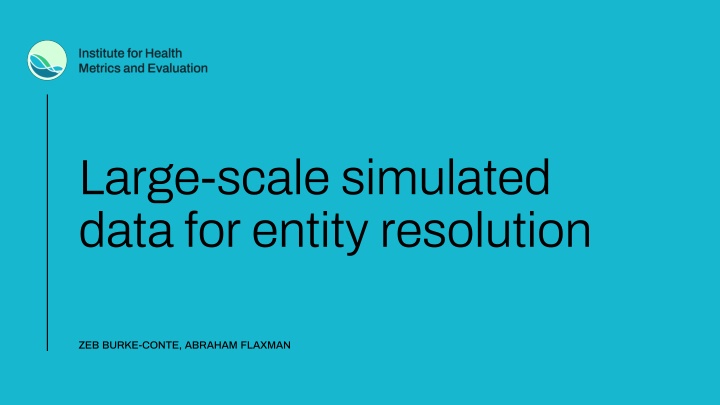
Simulated Data for Entity Resolution: Pseudopeople Highlights
Explore the use of pseudopeople, a Python package generating realistic simulated data for entity resolution. Learn about the benefits, including scalability, verifiability, and customization. Discover how this tool can facilitate testing and collaboration in data science projects.
Download Presentation

Please find below an Image/Link to download the presentation.
The content on the website is provided AS IS for your information and personal use only. It may not be sold, licensed, or shared on other websites without obtaining consent from the author. If you encounter any issues during the download, it is possible that the publisher has removed the file from their server.
You are allowed to download the files provided on this website for personal or commercial use, subject to the condition that they are used lawfully. All files are the property of their respective owners.
The content on the website is provided AS IS for your information and personal use only. It may not be sold, licensed, or shared on other websites without obtaining consent from the author.
E N D
Presentation Transcript
Large-scale simulated data for entity resolution ZEB BURKE-CONTE, ABRAHAM FLAXMAN
BACKGROUND Entity resolution, a.k.a. record linkage, data linkage Anytown survey of pet ownership Anytown tax filings First name Last name Date of birth Has a dog? First name Last name Date of birth Income Diana Kelly 05/06/1994 Yes Gerald Allen 11/03/1943 $30,000 Gerald Alen 11/03/1943 No Diana Kelly 06/05/1994 $65,000 Vicki Simmons 04/21/1992 No Victoria Simmons 04/21/1992 $50,000 First name Last name Date of birth Has a dog? Income Diana Kelly 05/06/1994 Yes $65,000 Gerald Allen 11/03/1943 No $30,000 Vicki Simmons 04/21/1992 No $50,000 2
BACKGROUND Barriers to testing and collaborating By definition, the data used in entity resolution is personally identifiable personally identifiable Difficult to (safely) share examples or compare notes Have to bring software into a secure environment before truly testing it 3
PSEUDOPEOPLE Introducing: 4
PSEUDOPEOPLE pseudopeople is a Python package that generates realistic simulated data about a fictional United States population, designed for use in testing entity resolution (record linkage) methods or other data science algorithms at scale. Simulated Simulated: These are made-up people! No need to worry about confidentiality. Versatile Versatile: Generate multiple datasets about the same population: censuses, surveys, and administrative records. Verifiable Verifiable: Ground-truth unique identifiers are present in every dataset for checking link correctness. Customizable Customizable: Configure the levels of noise in each dataset. Full Full- -scale scale: Supports generating datasets at the size of the real-life US population. 5
PSEUDOPEOPLE Highlights Individual Individual- -based microsimulation based microsimulation of US population dynamics for multiple decades decades Paper about simulation methods will be published soon Generate datasets datasets about this simulated population: Decennial Census, taxes, surveys, and more! Configurable noise noise in the data collection process (inspired by FEBRL, GeCo) Small (~10k people) simulated population in Anytown, WA included Simple process to request simulated Rhode Island (~1 million people) or full USA (~330 million) 6
PSEUDOPEOPLE Live demo Demo notebook: https://colab.research.google.com/drive/1wJ6_Y5L6EOyAX5nL2iNTRgs8D_kwBlqW?usp=sharing Want to learn more? https://pseudopeople.readthedocs.io/ 7
PERSON LINKAGE CASE STUDY A case study for person linkage Concrete, fully-reproducible approximation of the methods the Census Bureau routinely uses to link large datasets Uses data from pseudopeople pseudopeople can directly measure accuracy of the result! Built on Splink Splink (UK Ministry of Justice entity resolution tool in the Fellegi-Sunter paradigm) Modeled after public descriptions of the Person Identification Validation System (PVS) Goals: Highlight methods that are under-discussed in the literature Help researchers evaluate new methods with a realistic example 8
PERSON LINKAGE CASE STUDY Person linkage case study: overview Imagined scenario: adding person identifier to a simulated 2030 Decennial Census Simulated reference file Person ID First name Last name 1 Gerald Allen 2 Diana Kelly Simulated 2030 Census with person ID Simulated 2030 Census First name Last name First name Last name Person ID Diana Kelly Diana Kelly 2 Gerald Allen Gerald Allen 1 Gerald Alen Gerald Alen 1 9
PERSON LINKAGE CASE STUDY Person linkage case study Simulated Social Security data linkage modules Simulated reference file Simulated tax data Household Composition Search Geographic Search Date of Birth Search Name Search Simulated 2030 Census Input file pre- processing File with person IDs 10
PERSON LINKAGE CASE STUDY Person linkage case study highlights Versions for each population size (10k, 1M, 330M) At full scale, 12TB of RAM, 200 cores, ~24 hours 1.7B input records, 207B record pairs compared! Work in progress to make this possible (though slower) on a single large machine Interested? Reach out to us! Reach out to us! Zeb Burke-Conte Researcher zmbc@uw.edu Abraham Flaxman Associate Professor abie@uw.edu 11
